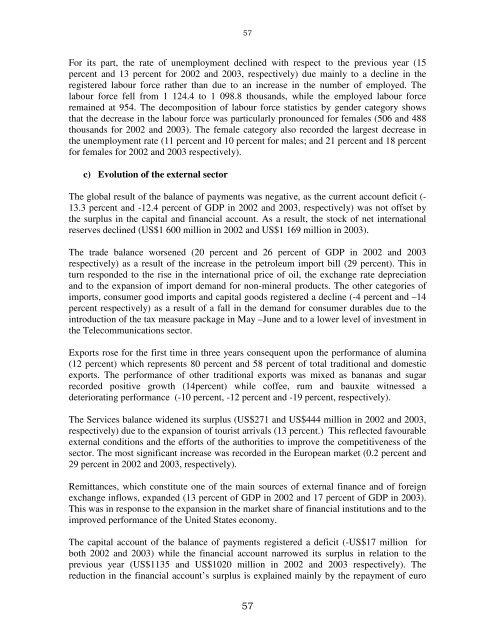Jamaica: Macro-Socio-Economic and Environmental Assessment of ...
Jamaica: Macro-Socio-Economic and Environmental Assessment of ...
Jamaica: Macro-Socio-Economic and Environmental Assessment of ...
Create successful ePaper yourself
Turn your PDF publications into a flip-book with our unique Google optimized e-Paper software.
57<br />
For its part, the rate <strong>of</strong> unemployment declined with respect to the previous year (15<br />
percent <strong>and</strong> 13 percent for 2002 <strong>and</strong> 2003, respectively) due mainly to a decline in the<br />
registered labour force rather than due to an increase in the number <strong>of</strong> employed. The<br />
labour force fell from 1 124.4 to 1 098.8 thous<strong>and</strong>s, while the employed labour force<br />
remained at 954. The decomposition <strong>of</strong> labour force statistics by gender category shows<br />
that the decrease in the labour force was particularly pronounced for females (506 <strong>and</strong> 488<br />
thous<strong>and</strong>s for 2002 <strong>and</strong> 2003). The female category also recorded the largest decrease in<br />
the unemployment rate (11 percent <strong>and</strong> 10 percent for males; <strong>and</strong> 21 percent <strong>and</strong> 18 percent<br />
for females for 2002 <strong>and</strong> 2003 respectively).<br />
c) Evolution <strong>of</strong> the external sector<br />
The global result <strong>of</strong> the balance <strong>of</strong> payments was negative, as the current account deficit (-<br />
13.3 percent <strong>and</strong> -12.4 percent <strong>of</strong> GDP in 2002 <strong>and</strong> 2003, respectively) was not <strong>of</strong>fset by<br />
the surplus in the capital <strong>and</strong> financial account. As a result, the stock <strong>of</strong> net international<br />
reserves declined (US$1 600 million in 2002 <strong>and</strong> US$1 169 million in 2003).<br />
The trade balance worsened (20 percent <strong>and</strong> 26 percent <strong>of</strong> GDP in 2002 <strong>and</strong> 2003<br />
respectively) as a result <strong>of</strong> the increase in the petroleum import bill (29 percent). This in<br />
turn responded to the rise in the international price <strong>of</strong> oil, the exchange rate depreciation<br />
<strong>and</strong> to the expansion <strong>of</strong> import dem<strong>and</strong> for non-mineral products. The other categories <strong>of</strong><br />
imports, consumer good imports <strong>and</strong> capital goods registered a decline (-4 percent <strong>and</strong> –14<br />
percent respectively) as a result <strong>of</strong> a fall in the dem<strong>and</strong> for consumer durables due to the<br />
introduction <strong>of</strong> the tax measure package in May –June <strong>and</strong> to a lower level <strong>of</strong> investment in<br />
the Telecommunications sector.<br />
Exports rose for the first time in three years consequent upon the performance <strong>of</strong> alumina<br />
(12 percent) which represents 80 percent <strong>and</strong> 58 percent <strong>of</strong> total traditional <strong>and</strong> domestic<br />
exports. The performance <strong>of</strong> other traditional exports was mixed as bananas <strong>and</strong> sugar<br />
recorded positive growth (14percent) while c<strong>of</strong>fee, rum <strong>and</strong> bauxite witnessed a<br />
deteriorating performance (-10 percent, -12 percent <strong>and</strong> -19 percent, respectively).<br />
The Services balance widened its surplus (US$271 <strong>and</strong> US$444 million in 2002 <strong>and</strong> 2003,<br />
respectively) due to the expansion <strong>of</strong> tourist arrivals (13 percent.) This reflected favourable<br />
external conditions <strong>and</strong> the efforts <strong>of</strong> the authorities to improve the competitiveness <strong>of</strong> the<br />
sector. The most significant increase was recorded in the European market (0.2 percent <strong>and</strong><br />
29 percent in 2002 <strong>and</strong> 2003, respectively).<br />
Remittances, which constitute one <strong>of</strong> the main sources <strong>of</strong> external finance <strong>and</strong> <strong>of</strong> foreign<br />
exchange inflows, exp<strong>and</strong>ed (13 percent <strong>of</strong> GDP in 2002 <strong>and</strong> 17 percent <strong>of</strong> GDP in 2003).<br />
This was in response to the expansion in the market share <strong>of</strong> financial institutions <strong>and</strong> to the<br />
improved performance <strong>of</strong> the United States economy.<br />
The capital account <strong>of</strong> the balance <strong>of</strong> payments registered a deficit (-US$17 million for<br />
both 2002 <strong>and</strong> 2003) while the financial account narrowed its surplus in relation to the<br />
previous year (US$1135 <strong>and</strong> US$1020 million in 2002 <strong>and</strong> 2003 respectively). The<br />
reduction in the financial account’s surplus is explained mainly by the repayment <strong>of</strong> euro<br />
57
















